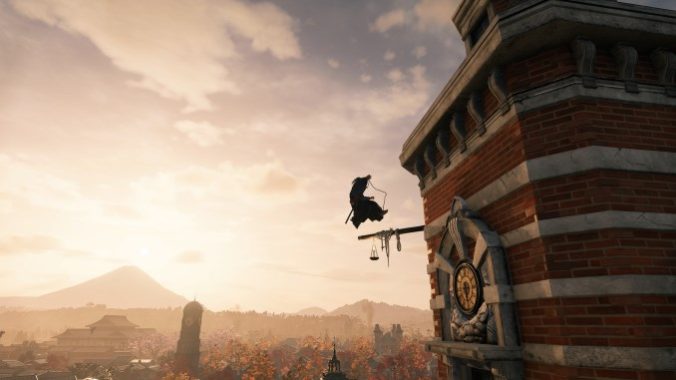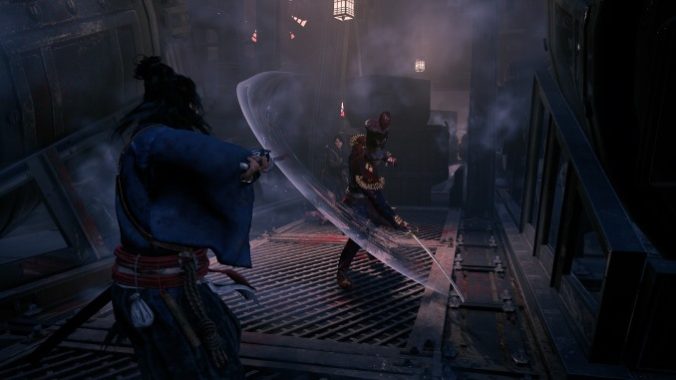
Like the rising of the sun, like the waning of the moon, as sure as night follows day and death follows life: Team Ninja will release a stone cold classic 7/10 once every 12 to 18 months. It will have gripping, satisfying combat that pushes your reaction timing and rapid-fire strategizing to the test. It will have a loot system designed by The Devil. It will have a breadth of toolkits and approaches to encounters that put damn near every other action game to shame. It won’t have anywhere near enough enemy variety to use it all on. It will run like total shit. It will inexplicably go on for 70 hours. The Izuna Drop will never once get old. It is the best of times, it is the worst of times, it is pure and undistilled uncut gaming. Rise of the Ronin is in stores now.
But there’s a catch: Rise of the Ronin is not merely a new Team Ninja action game, it is an Open World Game, a Sony Published PS5 Exclusive Blockbuster, in a collaboration that is as revealing as it is baffling. The Sony Prestige RPG is a well established form, valuing seamless integration between its gameplay and narrative systems, combat that is graphically impressive but mechanically shallow enough to not scare a mass audience away, and a character driven story with a polished presentation. Rise of the Ronin is, it brings me great pleasure to say, none of these things. It is a god damn videogame in every way, and every step closer it takes towards the PlayStation cinematic ideal only serves to reveal how vast the canyon is.
A short prologue establishes your character, a Blade Twin of the Veiled Edge, raised from birth as an invisible anti-shogunate assassin, in pursuit of your other half against the backdrop of the rising tensions that will lead to the Boshin War. Afterwards, you arrive in the open world and immediately clear a village of bandits, and a tooltip explains that establishing Public Order will raise your Bond Level. Your Bond Level with who? Excuse me? Why am I establishing Public Order anyway, aren’t I an anti-shogunate assassin? What do these meters actually represent; who in-universe is giving me loot for raising my Shibuya Bond Level? Such questions shall go unanswered. This would not raise an eyebrow in Nioh, a menu driven game filled with initially confusing and overwhelming systems, but placed into juxtaposition with the cinematic prologue the sheer videogame of it all is overwhelming.
When you accept this and settle into its open world rhythms, you may hit upon a realization: Rise of the Ronin feels ancient. This is no bad thing. The world is pure Assassin’s Creed Brotherhood specifically, dense cities and surrounding farmland, jumping over rowhouse roofs to land assassinations from above. Even the glider, a modern Open World staple, is modeled directly off Arkham City and not Breath of the Wild. The world is well designed too, with a great sense of art design, its three cities fading into the foggy distance with beautiful skyboxes of Mt. Fuji. The districts each feel distinct, with enemy camps identified by billowing smokestacks and shrines hiding off the beaten path behind Torii gates, reducing the need for constantly opening the map like it’s a menu. But ultimately this is not a game of exploration and discovery; even as an intentional throwback this is still an open world of Content and Checklists, placing the burden on the combat to be excellent.
Which, of course, it is.

Rise of the Ronin’s combat is built clearly out of the bones of Nioh and Team Ninja’s other recent games, but it moves the camera down and to the right while restricting movement, creating a completely different feel that emphasizes the sword duels the game is going for. Battles revolve around timing parries around the enemy attacks, while managing your Ki and Blood meters to keep up the pressure without running out of stamina yourself and being left open for a counter. You only have a single combo string (though can vary between stances and weapons on the fly), placing the focus not on combo expression but on reading and reacting to your enemies attack patterns. This mostly works in the game’s favor and greatly reduces the game’s initial complexity, in one area of concession to a new audience that benefits the game greatly. The enemies are aggressive, and there are a metric ton of weapons and stances to learn—both to use and react to. Nailing a parry feels incredible and the timing is just tight enough where it is always challenging but never impossible. It’s a genuinely incredible achievement how the appeal of this team’s combat design has been refined into something so approachable, without losing its core appeal in the process. There is no one better in the business at making you press Square to Swing a Sword.
However, the game’s structure works somewhat against this and it does eventually start to drag, as optimal strategies over repeated enemy types assert themselves throughout the course of play. There is an incredibly wide variety of weapons and stances, with different stealth and sub-weapon options in the mix, but systems like the skill tree advancements and weapon proficiency encourage you to stick with what you know. To play efficiently is to ignore everything that makes the game interesting, with a disappointing prioritization of numbers-go-up progression systems over pressure points that encourage the experimentation that makes the game sing.
But such a decision was only made because of another of the game’s core problems: it never ends. There are three open worlds packed with stuff to do, and that stuff to do never really changes. As 20 hours becomes 40 becomes 70, the magic inevitably starts to fade, and when a late-game world event has you revisiting many of the hundreds of camps and targets you already cleared mere missions before credits roll the amount of content ceases to be a bounty and has entirely become a burden.
You will note the one thing I have not mentioned so far has been deafening in its absence: the story. This is an open world RPG, a historical retelling of a chaotic chapter of Japan’s history, and the narrative has more importance here than in any other Team Ninja game. There is an unfortunate reason for that: it’s really bad.
The Meiji Restoration is an interesting period of history as it is broadly a revolutionary tragedy, a moment of great societal upheaval and change that led to the rise of a brutal nationalist empire modeled explicitly on western imperial methods. The Americans and British and French arrived and delivered the textbook for the horror of industrialized colonialism that would spread through Okinawa, Korea, Taiwan and further.

You would not know that to play Rise of the Ronin. There is so much dialogue from Shoin Yoshida and his students about a vague and generic need to “unite,” to “rise as one,” and that “change requires action,” which is less a platitude and more a statement of physical fact that even babies innately understand. Japan is “done for,” and someone has to “do something,” or maybe if you’re lucky, a declaration to “forge a new Japan.” The emptiness of these positions would be a normal kind of boring in a fantasy RPG about stopping the demon lord, but this is a story about real people, and real history, and the game desperately does not want to say what any of them actually believe.
Instead it tells a story of nominal and childish pacifism, where you fight for Peace against your Blade Twin, who fights for War because only conflict can bring about a new Japan, but you believe that cooperation and peace is the true path to a new Japan. How convenient that the game does not linger on what that new Japan actually was, that no one even says the word Empire, that it treats the Meiji Restoration as the peaceful reunion of a divided country in a pointless war and spares not one thought for what that day meant for its neighbors, or even its workers.
That isn’t to say there’s nothing at all to enjoy in the story. There’s some good moments, some fun side characters. But this core issue is so totalising that it drags everything down around it, the game constantly walking on eggshells around its chosen topic, aware of the potential for offense but not brave enough to interrogate its own narrative, that the story ends up as disappointing noise between the punctuating highs of incredible combat.
After Spider-Man 2 was released, a leaked Insomniac presentation revealed the developers asking if players would even notice the extra hundreds of millions poured into the game’s already expensive development. Rise of the Ronin shows exactly what that money buys. From the awkward horse animation to the silent protagonist, in every cutscene fading out to a loading screen instead of dynamically swinging back behind the protagonist, in the constant tooltip tutorials and the entirely unmotivated progression systems with no contextualisation in the world. What that extra investment brought to Insomniac is polish, that is the money and time and Labor that the Sony Blockbuster sells itself on. And Rise of the Ronin rejects this, instead focusing on what Team Ninja has always done well. It has some new frustrations in the story, and retains old ones in the loot system. It doesn’t do enough to win the Ghost of Tsushima and Horizon fans over, but only because it’s too busy honing the blade. You only have to hit one parry to know that sword to sword, none of those games can compete. Team Ninja has done it again. Is it for you? You should already know by now. But I hope we can do this again next year.
Rise of the Ronin was developed by Team Ninja and published by Sony. It’s available for the PlayStation 5.
Jackson Tyler is an nb critic and podcaster at Abnormal Mapping. They’re always tweeting at @headfallsoff.